THANK YOU!
YOUR PURCHASE OF THESE BOOKS SUPPORTS THE WEB SITES THAT BRING TO YOU THE HISTORY BEHIND OLD AIRFIELD REGISTERS
Your copy of the Davis-Monthan Airfield Register 1925-1936 with all the pilots' signatures and helpful cross-references to pilots and their aircraft is available at the link. 375 pages with black & white photographs and extensive tables
---o0o---
The Congress of Ghosts (available as eBook) is an anniversary celebration for 2010. It is an historical biography, that celebrates the 5th year online of www.dmairfield.org and the 10th year of effort on the project dedicated to analyze and exhibit the history embodied in the Register of the Davis-Monthan Airfield, Tucson, AZ. This book includes over thirty people, aircraft and events that swirled through Tucson between 1925 and 1936. It includes across 277 pages previously unpublished photographs and texts, and facsimiles of personal letters, diaries and military orders. Order your copy at the link.
---o0o---
Military Aircraft of the Davis Monthan Register 1925-1936 is available at the link. This book describes and illustrates with black & white photographs the majority of military aircraft that landed at the Davis-Monthan Airfield between 1925 and 1936. The book includes biographies of some of the pilots who flew the aircraft to Tucson as well as extensive listings of all the pilots and airplanes. Use this FORM to order a copy signed by the author, while supplies last.
---o0o---
Art Goebel's Own Story by Art Goebel (edited by G.W. Hyatt) is written in language that expands for us his life as a Golden Age aviation entrepreneur, who used his aviation exploits to build a business around his passion. Available as a free download at the link.
---o0o---
Winners' Viewpoints: The Great 1927 Trans-Pacific Dole Race (available as eBook) is available at the link. This book describes and illustrates with black & white photographs the majority of military aircraft that landed at the Davis-Monthan Airfield between 1925 and 1936. The book includes biographies of some of the pilots who flew the aircraft to Tucson as well as extensive listings of all the pilots and airplanes. Use this FORM to order a copy signed by the author, while supplies last.
---o0o---
Clover Field: The first Century of Aviation in the Golden State (available in paperback) With the 100th anniversary in 2017 of the use of Clover Field as a place to land aircraft in Santa Monica, this book celebrates that use by exploring some of the people and aircraft that made the airport great. 281 pages, black & white photographs.
---o0o---
Some of this information comes from the biographical file for pilot Collins, CC-438005-01, reviewed by me in the archives of the National Air & Space Museum (NASM), Washington, DC.YOU CAN HELP
I'm looking for information and photographs of Collins and his airplane to include on this page. If you have some you'd like to share, please click this FORM to contact me.
---o0o---
SPONSORED LINKS
HELP KEEP THESE WEB SITES ONLINE
FOR YOUR CONVENIENCE
You may NOW donate via PAYPAL by clicking the "Donate" icon below and using your credit card. You may use your card or your PAYPAL account. You are not required to have a PAYPAL account to donate.
When your donation clears the PAYPAL system, a certified receipt from Delta Mike Airfield, Inc. will be emailed to you for your tax purposes.
---o0o---
JAMES H. "Jimmy" COLLINS
"Never mind wiping my face, I'm done."
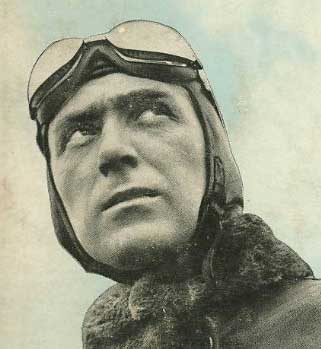 |
Jimmy Collins landed once at Pitcairn Field, on Wednesday, August 31, 1932. Based at Roosevelt Field, NY, he was solo in an unidentified (but see below) Lockheed Sirius. Photograph, left, is from the dust cover of a book he published in 1935.
Collins, if not one of the more introspective of our Register pilots, certainly is one who most articulated his thoughts in the press for us to ponder. He wrote numerous newspaper articles and a single book, which received a good review in The New York TImes (see below).
Forced by economic circumstances during the 1930s, he chose to take employment where and when he could. He became a well-known flyer in the greater New York City area because of his experiences test-flying Navy warplanes. He was hired to push the limits of the performance envelope for the aircraft. Besides aerobatic maneuvers and speed tests, he also performed dive tests. It was a dive test with a Grumman F3F that was his final flight. The quote above represents his final words as cited in The New York Times shortly after his death. His airplane was a prototype of the F3F-2.
From his book, Collins was born in Warren, OH on April 25, 1904. He was killed March 22,1935 at age 36. The article, below, courtesy of The New York Times (NYT) of March 23rd, describes the crash and the aftermath. A YouTube video of a Grumman F3F-2 at the link shows the airplane as flight tested in 1936 by Register pilot Lee Gehlbach. Note in the video the execution of dives of the type that killed Collins. That Collins was killed probably led to strength improvements that allowed Gehlbach to dive safely. However, a month later Gehlbach had to exit another F3F via parachute after getting into a spin he couldn't recover from.
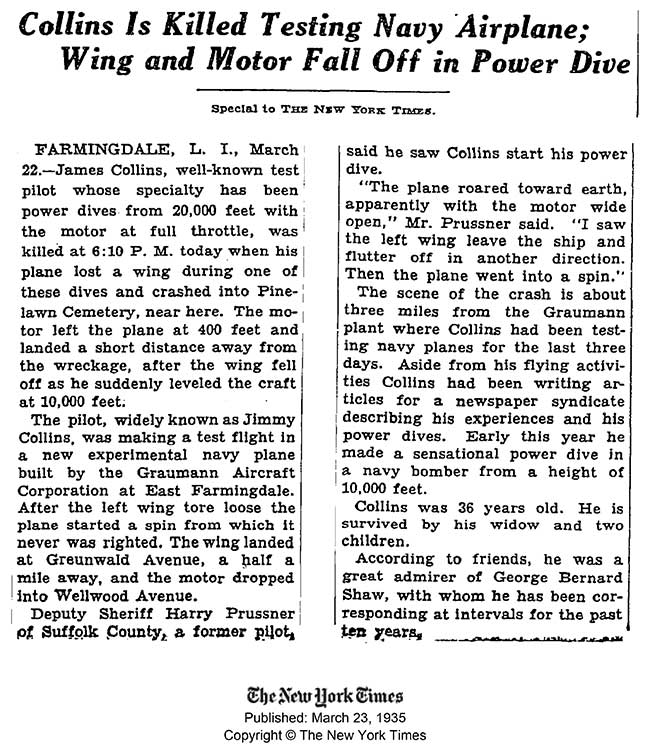 |
Another YouTube video shows a contemporary, restored F3F-2 in flight. This video has sound.
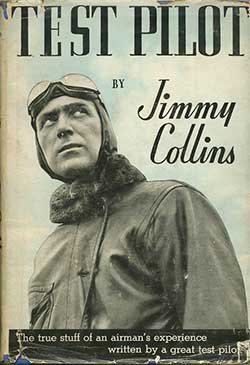 |
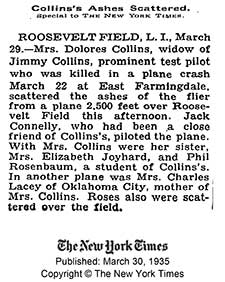 |
As well as being a seasoned aviator/test pilot, Collins was a published author, who, shortly before his death, wrote a book in 1935 entitled "Test Pilot" (dust cover of the book is at right). This short (96 pages), very readable book provides candid, fascinating views of what it was like to fly commercially and as a test pilot in the 1920s and 30s. The book was actually published posthumously by his wife. Interestingly, the jacket description foresees "The Right Stuff."
"Test Pilot" is out of copyright now, so I have made it available as a PDF download at the link (884Kb). I have added some controls to the text for electronic reading. For your convenience, his text, downloaded from the gutenberg.org Web site, has been enhanced with internal hyperlinks from the Table of Contents to the individual chapters, and back again. It should work fine on any device with Adobe Reader 10.0.
Collins was the youngest of a family with seven siblings. His paternal grandfather came to the U.S. from Ireland. He wasn't far removed from his roots. His parents died when he was young. He made it through grammar school, and two years of high school, by the time his mother died.
He left school temporarily; worked from age 16 at various jobs, then negotiated an arrangement with his employer (Goodrich Rubber Factory in Akron, OH) that allowed him to work a part shift at night and attend school during normal hours. In three years he had completed high school and a year of college at Akron.
In 1924, he applied for entrance to the United States Army Air Service Primary Flying School. He was examined, found qualified, and admitted. One hundred and four others were admitted to this same class. Charles A. Lindbergh was one of them.
A year later, in March, 1925, Collins was one of eighteen who graduated from the Army Advanced Flying School, Kelly Field, San Antonio, TX. The rest of the 104 had been disqualified during the course, only the eighteen most apt being kept. Of these eighteen who graduated, four had been chosen to specialize in pursuit flying. Lindbergh and Collins were two of these four. Upon graduating from the Advanced Flying School, Collins was discharged from the army, and commissioned a second lieutenant in the United States Army Air Corps.
The first chapter of Collins' book goes into the details of his life over the next three years. Briefly, he left the Army in 1928 (one source says 1927) to try a civilian job, but found no aviation-related work. He found a non-aviation job, but it proved unsuitable and he went back into the Army. Being a man of intellect, Collins read widely while in the Army and developed a philosophy of socialism and pacifism, both of which placed him in a moral dilemma regarding his military service.
However, Lindbergh's trans-Atlantic flight a year earlier made aviators with four years of military flight training a desirable commodity. He took a job as airplane and engine inspector for the newly formed aeronautic branch of the Department of Commerce.
He spoke of that job in a way many 21st century employees can identify, "I found the post very uncongenial because I found myself with no assistant, swamped with more work than I could adequately have handled even with a couple of assistants, and because there was too much paper work and office work and too little flying. So, six months later, after receiving a pay raise and a letter of commendation, I resigned from the department and I took a job with Curtiss Flying Service, which I found much more congenial because it was almost purely a flying job."
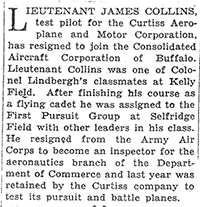 |
His work with Curtiss was what launched him into his test pilot work, viz., "My work there soon attracted the attention of the Curtiss Airplane and Motor Company, and I was asked to become their chief test pilot, which I did in November, 1928." He worked his way up in the company, but, in his off-hours he advocated for a socialist organization that the powers-that-be didn't like. Collins lost his job. Not to be deterred, he then went to work for the Consolidated Aircraft Corporation in Buffalo, NY. This transition was documented in The New York Times of April 21, 1929 at right.
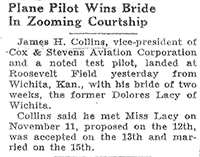 |
About six-months later he was married to Dolores Lacy (1909-2009) on November 25, 1929. Some sources spell her name Delores. The circumstances surrounding their wedding were recorded in The New York Times of December 2, 1929, left. Their meeting, courtship and marriage were nothing if not whirlwind. They had two children, son Darr (1933-1981) and daughter Susan Ann (1934-2009). The death dates of mother (April, 2, age 99) and daughter (June 20, age 75) are not coincident, but very close. Curiously, nothing is mentioned in his book about his employment with Cox & Stevens Aircraft Corp, makers of aviation instrument in Mineola, LI, NY, cited in this article, or about his work with Consolidated Aircraft cited in the article above, right.
During July, 1930, Collins made a cross-continent speed record attempt. Chances are the airplane he flew to Pitcairn Field was the Sirius NC or NR116W, with which he had attempted his west-east record two years previously. Below, courtesy of Tim Kalina, is a photograph of Collins seated in NR116W in 1930.
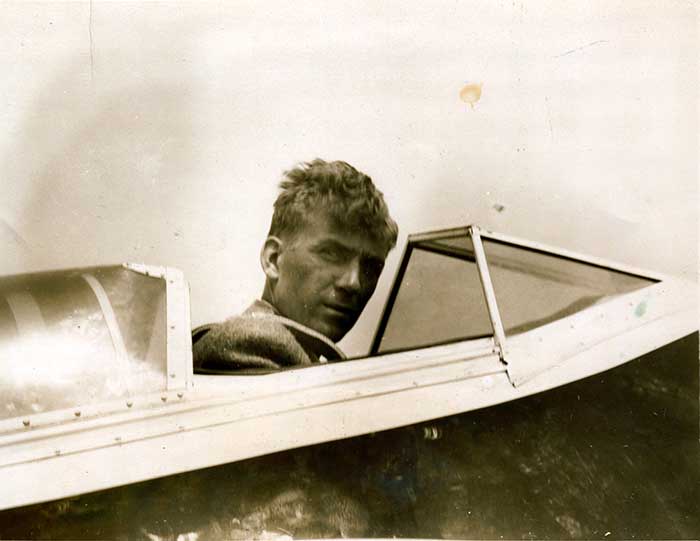 |
The caption on this photo's reverse gives a date of July 5, 1930 and mentions that Collins had failed to set a new cross-country record after flying from Burbank to Roosevelt Field. Time given for his attempt on July 4 was 16 hours and 10 minutes, which was about 2 hours longer than Lindbergh's current record set in his Sirius. His attempt and his single fuel stop, were documented in The New York Times of July 5, 1930, below.
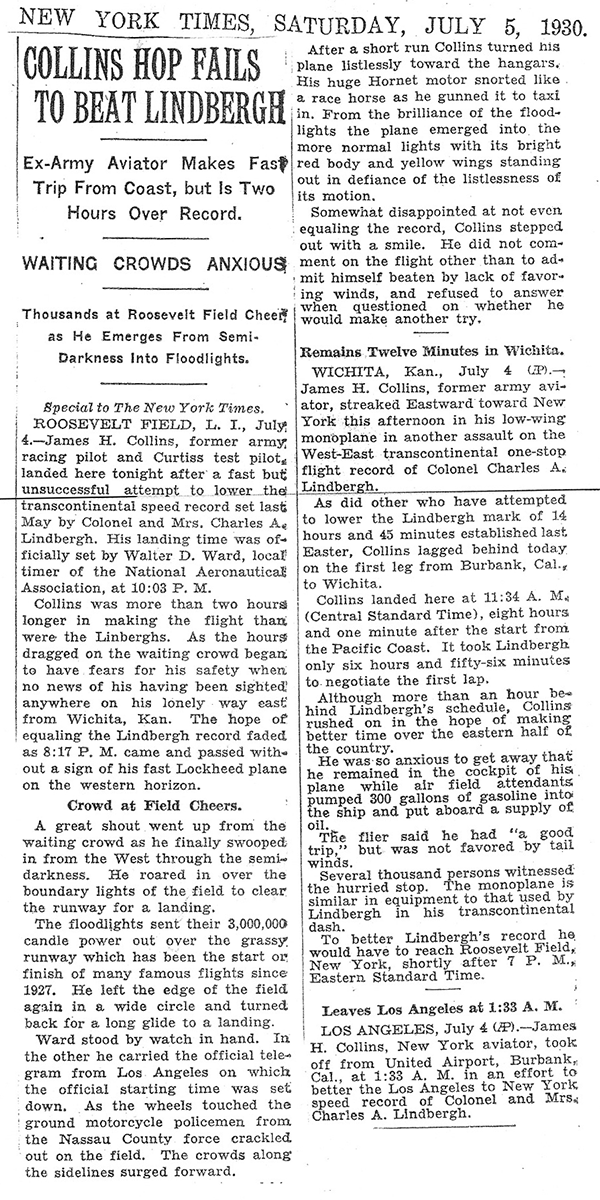 |
But, where were we? At some point he parted ways with both Consolidated and Cox & Stevens. With his now wife and two children in Oklahoma with his in-laws, Collins pondered his next steps in the throes of the Great Depression. By luck, he was offered a job to dive a new fighter-bomber for the Navy. For $1,500 he took the job with some trepidation and he wrote in his book, "I had dived airplanes before. The last one, six years before, I had dived to pieces. I still remembered the exploding crack of those wings tearing off. I remember the dazing blow of the instrument board as my head had snapped forward against it from the sudden lurch of the midair failure, and dimly then the slow, limp slumping into unconsciousness. I remembered how I had come to, thousands of feet later, and leaped my way clear, only to be threatened by the falling wreck on top and the rushing-at-me earth beneath. I remembered the tumbling, jerking stop as my chute had opened after the long drop, and how startlingly close the ground had looked. I remembered how white and safe against the blue sky those billowing folds of that chute had looked, and then immediately the awful heart-pound, breath-stop fear that that milling wreck would take a derelict pass at it. I remembered the acute relief of hearing the loud report that told me the wreck had hit the ground, and then the 'What if that had clutched me!' when they told me afterward how close it really had come."
The remainder of Collins' book consists of a couple of dozen brief chapters, more like vignettes, that provide the candid stories about flying and flyers that make his book compelling. His last chapter is, at best, unsettling. It foresees his own death, which came during a dive of a Navy airplane similar to the one he described above. Below, courtesy of The New York Times, is a book review published September 5,1935, six months after his death.
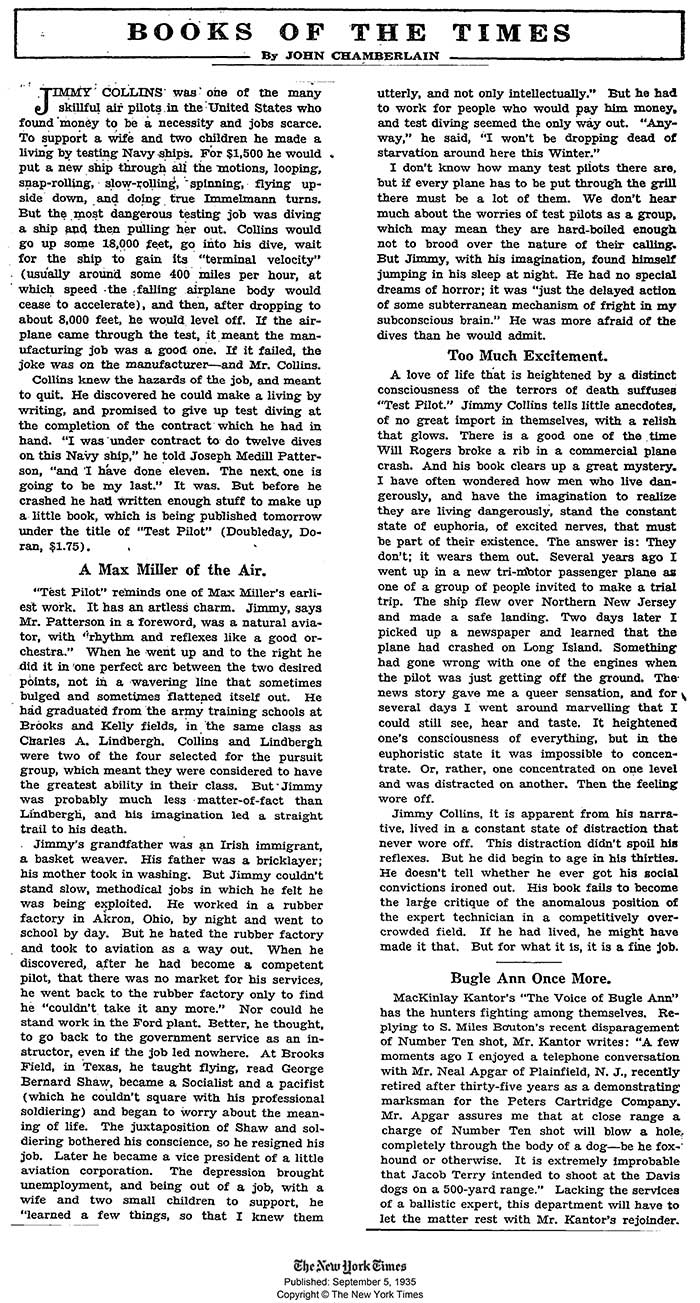 |
Below is another obituary, this one from the New York American of March 23, 1935. Compare this citation and the obituary exhibited above from The New York Times of the same date and note the reporting discrepancies between how Collins' airplane broke apart and his last words. Note also the absense of mention of Collins' daughter Susan Ann, who, at the time, was an infant just past a year old (b. March 9, 1934).
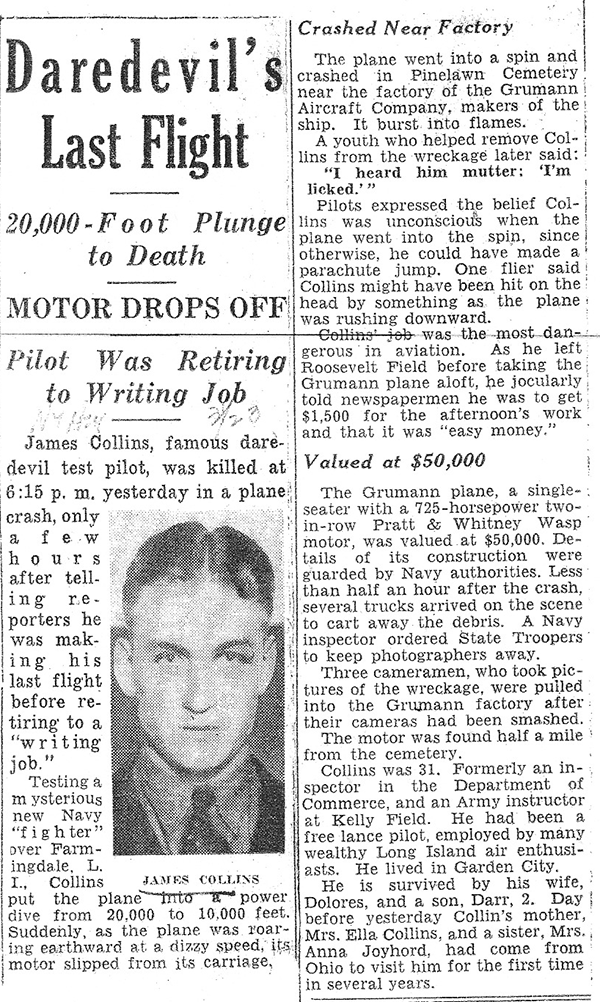 |
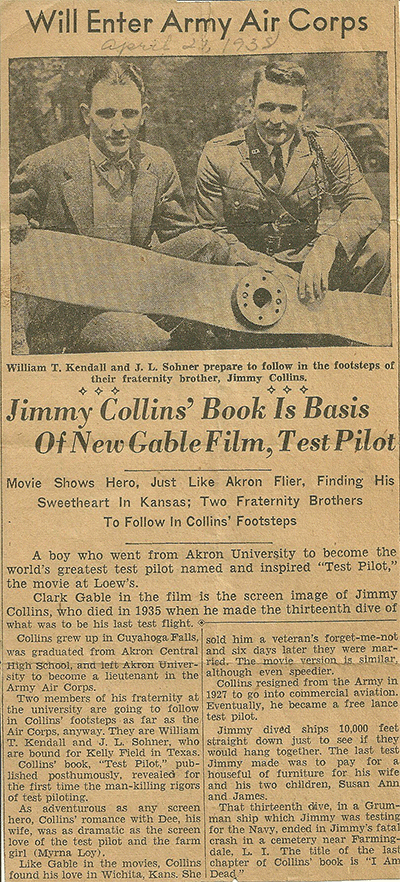 |
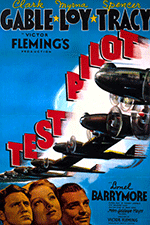 |
Collins' book was allegedly the inspiration for the 1938 classic aviation film "Test Pilot" starring Clark Gable, Myrna Loy and Spencer Tracy, right. An article, left, from an unidentified newspaper can be found on ancestry.com. The movie poster, right, can be viewed at the Turner Classic Movie (TCM) site at the link. A "Test Pilot" movie trailer is at the link.
Strangely, I could find no reference online that cites the Collins book provenance as related to this motion picture. The film's director, Victor Fleming, was himself a pilot and would surely have known about Collins' book. Indeed, the TCM link states that the film was, "Based on a Frank 'Spig' Wead story."
Regardless of the inspiration or provenance, if you read Collins' book at the PDF link above and compare the story line with that of the film, you'll find remarkable likenesses. Perhaps Wead read Collins' book and the book inspired his story.
As is common among Register pilots, Collins also landed once at Tucson, AZ and is signed in the Davis-Monthan Airfield Register at the link. Whereas he was a civilian pilot in 1932 when he landed at Willow Grove, he was still in the military when he landed at Tucson Thursday, December 8, 1927.
Collins' wife Dolores remarried in May, 1938 in St. Louis, MO to John Henderson (1909-1987), a casting director in the motion picture industry. She appears in the 1940 U.S. Census living in Detroit, MI with her new husband and children.
Dossier 2.2.56
---o0o---
SPONSORED LINKS
THIS PAGE UPLOADED: 8/2/15 REVISED: 10/25/15
